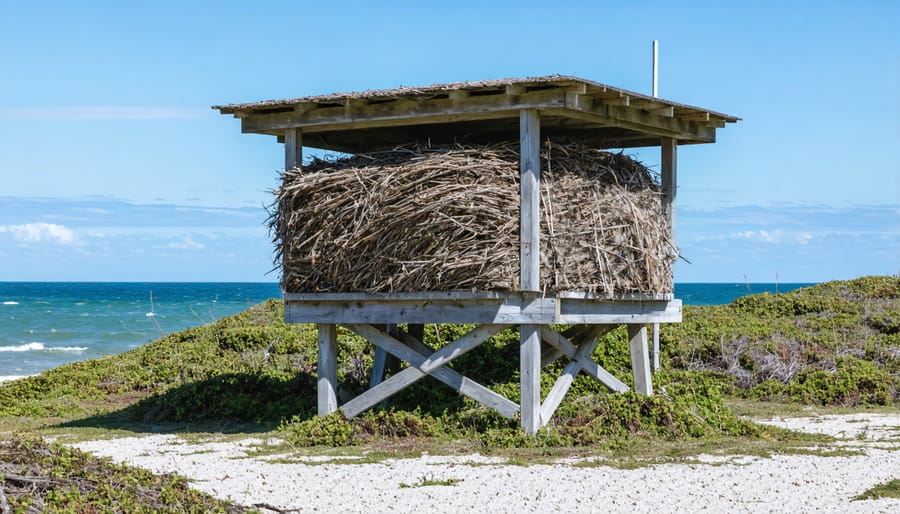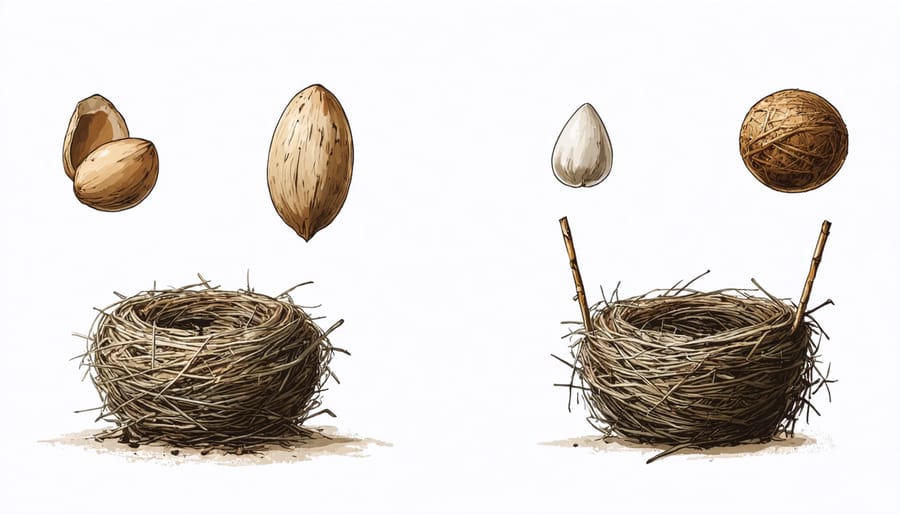
Natural Nesting Materials That Keep Coastal Bluebirds Coming Back
Collect pine needles, dried grass, and small twigs in early spring to create an irresistible nesting foundation for bluebirds in coastal areas. Place these materials in shallow, weather-resistant containers or specialized nesting boxes mounted 5-6 feet above ground, sheltered from prevailing winds. Create diverse nesting bundles by mixing soft, natural fibers like cotton, wool, and plant down with sturdier materials that can withstand coastal humidity and salt spray. Strategic placement of nesting materials near water features and native plantings helps attract coastal birds while providing essential protection from predators. Avoid synthetic fibers, dryer lint, or chemically treated materials that could harm bluebird chicks or break down in humid coastal conditions.
Essential Nesting Materials for Coastal Bluebirds
Natural Fiber Options
Natural fibers make excellent nesting materials for bluebirds, especially in coastal areas where durability is crucial. Pine needles are a top choice, as they’re naturally weather-resistant and maintain their structure even in humid conditions. These slender fibers are perfect for bluebirds to weave into their cup-shaped nests, and they’re usually abundant in coastal regions.
Long, dry grass is another fantastic option that bluebirds love. Look for grass that hasn’t been treated with pesticides and has dried naturally. The flexible nature of grass stems allows birds to create tight, sturdy nests that can withstand coastal breezes.
Other natural materials that work well include small twigs, bark strips from cedar or birch, and plant down from cattails or milkweed. In coastal areas, you might also find Spanish moss, which bluebirds can use to line their nests. Just ensure any collected materials are clean and free from mold, which can be more prevalent in humid coastal environments.
When gathering these materials, spread them in loose piles near your bluebird houses, keeping them elevated off the ground to prevent moisture absorption. This makes it easy for the birds to find and select the perfect pieces for their nests.

Weather-Resistant Materials
In coastal areas, selecting weather-resistant nesting materials for bluebirds requires special consideration due to salt air and high moisture levels. Natural cotton fibers, while popular inland, can quickly become waterlogged and moldy in coastal conditions. Instead, opt for materials like pine needles, small twigs, and dry grass that naturally resist moisture and salt damage.
Horse hair and animal fur work exceptionally well in coastal environments as they contain natural oils that repel water. Cedar bark strips are another excellent choice, as cedar’s natural preservative properties help it withstand harsh coastal conditions while providing excellent insulation for nesting birds.
When providing these materials, place them in a covered area or special nesting material holder to keep them dry. Avoid synthetic materials like dryer lint or yarn, which can retain moisture and potentially harm the birds. Replace wet or salt-crusted materials regularly during the nesting season to ensure bluebirds have access to clean, dry options.
For best results, offer a variety of these weather-resistant materials in small amounts, allowing the birds to select what works best for their needs. This approach ensures successful nest building even in challenging coastal conditions.
Creating Safe Nesting Material Stations
Location and Protection
When setting up nesting material stations in coastal areas, location is crucial for both accessibility and protection. Choose spots that are sheltered from strong sea breezes, ideally near natural windbreaks like shrubs or fences. Position your stations about 5-7 feet off the ground, ensuring they’re visible to bluebirds but protected from direct salt spray.
Consider creating multiple stations near your water features for wildlife, as bluebirds often search for nesting materials while visiting water sources. Place stations within 50-100 feet of existing bluebird houses or nesting boxes for convenient access.
To protect materials from coastal moisture, use covered dispensers or small weather-resistant containers with drainage holes. A simple mesh holder with an overhanging roof works well, allowing materials to stay dry while remaining easily accessible to birds. Position the opening away from prevailing winds to prevent materials from blowing away.
Regularly check and replenish materials, especially after storms or heavy winds. In coastal areas, materials can become damp or salt-laden quickly, so aim to refresh your stations every few days during peak nesting season. Remove any wet or soiled materials promptly to prevent mold growth and maintain healthy nesting conditions for your feathered friends.

Maintenance and Monitoring
Regular maintenance of bluebird nesting materials is crucial for ensuring the health and safety of these beloved birds. Check the nesting box weekly during breeding season to ensure materials remain dry and free from mold. If you notice any dampness, carefully remove wet materials and replace them with fresh ones, being mindful not to disturb any nesting activity.
Create a simple maintenance schedule that includes inspecting the nesting box’s drainage holes to prevent water accumulation. In coastal areas where humidity is high, consider adding small ventilation holes near the top of the box to promote air circulation and reduce moisture buildup.
Store extra nesting materials in a dry, covered container or sealed plastic bag to keep them ready for replacement. During wet weather, you might need to replace materials more frequently. A good practice is to prepare several small bundles of nesting material in advance, making it easier to quickly swap out damp materials when needed.
Monitor for signs of pest infestation, such as ants or parasites, which can be attracted to damp nesting materials. If you spot any issues, clean the box thoroughly with a mild solution of water and vinegar, allowing it to dry completely before adding fresh materials.
Remember to document your maintenance activities and any observations about the birds’ preferences for certain materials. This information can help you provide better nesting conditions in future seasons.

Materials to Avoid
While it’s important to provide nesting materials for bluebirds, some common items can actually harm these beautiful birds or fail to hold up in coastal conditions. Dryer lint, while often recommended for bird nests, breaks down quickly when wet and may contain harmful chemicals from laundry products. Similarly, synthetic materials like plastic strings, yarn, or thread can entangle birds and shouldn’t be offered.
Cotton balls and makeup removal pads might seem soft and cozy, but they retain moisture and can lead to hypothermia in chicks, especially in humid coastal environments. Human hair and pet fur treated with flea medications or other chemicals pose risks to both adults and nestlings. Long strands of any material can wrap around birds’ legs or wings, causing injury or death.
Avoid offering materials with a strong scent, such as cedar shavings or scented pine needles, as these can repel bluebirds. Paper products, including shredded paper or newspaper, quickly deteriorate in coastal moisture and can become moldy. Treated or painted wood shavings may contain toxic substances that could harm the birds.
Metal materials, including tinsel or decorative garlands, can cause injury and shouldn’t be used. In coastal areas, materials that easily absorb salt spray can become crusty and uncomfortable for nesting birds. Also, avoid providing materials collected from areas treated with pesticides or herbicides, as these chemicals can be harmful to bluebirds and their young.
Instead, stick to natural, weather-resistant materials that bluebirds would naturally find in their environment. This ensures both the safety of the birds and the durability of their nests in challenging coastal conditions.
Seasonal Considerations
Bluebirds have specific nesting needs that change throughout the breeding season, and adapting your nesting material offerings accordingly can significantly improve their success rate. In early spring, when bluebirds begin their nest-building activities, focus on providing materials that offer warmth and insulation against lingering cold temperatures. Pine needles, soft grasses, and fine plant fibers are excellent choices for this period.
As temperatures warm up in mid-spring, you can introduce a wider variety of materials. Thin, flexible plant stems and dried grasses become particularly valuable as they allow for better ventilation in the nest. For those living in coastal areas, understanding coastal wildlife management practices is essential, as materials need to withstand higher humidity and salt exposure.
During the peak summer months, consider offering materials that help keep the nest cool and well-ventilated. Light-colored grasses and plant fibers work best, as they reflect rather than absorb heat. Avoid providing synthetic materials like dryer lint or yarn during this time, as they can retain moisture and create uncomfortable conditions for the chicks.
For late-season broods, which often occur in mid to late summer, return to offering warming materials as nights begin to cool. This is particularly important for ensuring the survival of late-hatching chicks. Keep the material offerings fresh and dry, replacing any that become wet or moldy.
Remember to maintain a consistent supply throughout the entire breeding season, as bluebirds may produce multiple broods and often rebuild or repair their nests between clutches. Place materials in easy-to-spot locations within 50 feet of your nest boxes, ensuring the birds can access them while staying alert for predators.
Providing proper nesting materials for bluebirds is a rewarding way to support these beautiful native birds and contribute to their conservation. By offering appropriate materials like pine needles, fine grass, and small twigs in your yard, you’re helping ensure successful nesting seasons for generations of bluebirds. Remember to maintain a consistent supply throughout the breeding season and avoid materials that could harm the birds or their chicks. Consider joining local bluebird monitoring programs or sharing your experiences with other bird enthusiasts in your community. Every small effort helps protect these cherished songbirds, from installing proper nest boxes to providing safe, natural nesting materials. Together, we can create welcoming habitats that support thriving bluebird populations for years to come.
